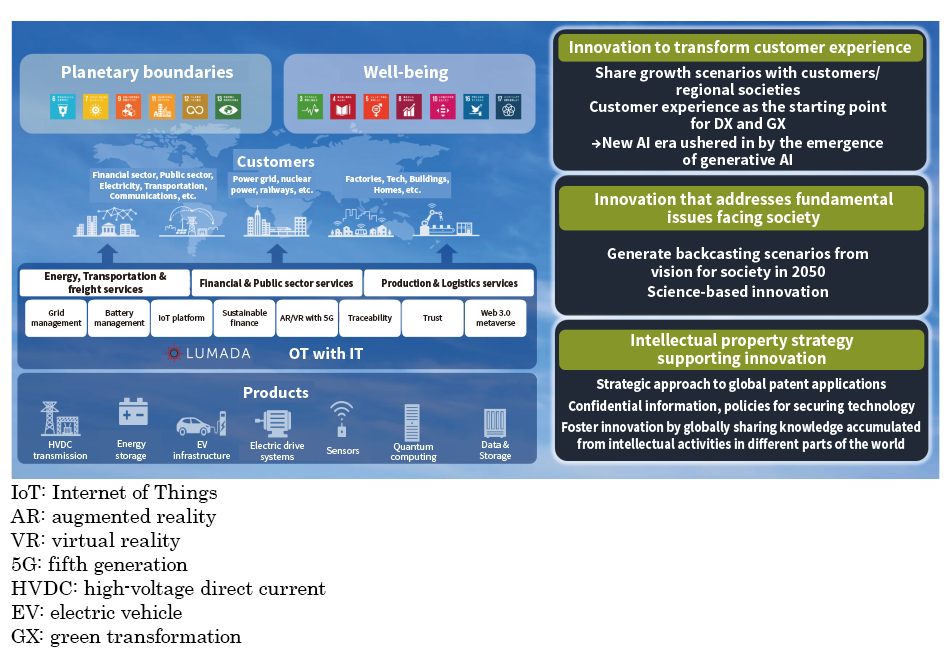AbstractResearch & Development
In recent years, we are being asked to respond to “polycrises” such as global boiling beyond global warming, emerging issues in biodiversity, and increases in cybersecurity threats, in which environmental, geopolitical, socioeconomic, and other factors such as resource risks are intertwined. To overcome these complex societal challenges, the Hitachi Group motivated by its wish to make society a better place, is engaging in co-creation with customers for social innovation.
Corporate research and development (R&D), which has a central role in innovation, is focusing on “innovations that transform customer experience,” “innovations that address the fundamental issues facing society,” and pursuing “value-driven” global intellectual property activities. Based on these activities, corporate R&D together with the business units is driving the Lumada growth cycle and creating new value as One Hitachi to achieve sustainable growth in partnership with customers.
Innovation to Transform Customer Experience
To solve customers’ next management challenges, Hitachi is expanding its unique customer co-creation approach, NEXPERIENCE, for innovation. A scenario for growth is created together with customers by capturing “future signs” of change in the environment surrounding customers and in society, and through repeated dialogue with customers to identify and gain a deep understanding of the user value from these insights. To realize the growth scenarios, R&D is developing digital solutions underpinned by Hitachi’s expertise in IT, operational technology (OT) and products together with our business units for our customers. Leveraging open innovation sites, such as the “Lumada Innovation Hub Tokyo” and “Kyōsō-no-Mori,” to allow our customers to experience innovation first hand, we are accelerating co-creation, growth for our customers and expansion of the Lumada business. This chapter introduces concrete examples such as:
Global co-creation and startup collaborations: Examples include a proof-of-concept (PoC) project for work safety improvement undertaken with France’s national railway, application of artificial intelligence (AI) to industry in the US, and co-creation projects in various regions of Japan.
Digital systems & services: Examples include digital transformation (DX) of societal infrastructure maintenance and supply chains, innovation in infrastructure management and security technology that needs to be tailored to specific domains, and generative AI. In recent years, generative AI has attracted global attention and its use is bringing a variety of changes to society. At Hitachi, we aim to innovate labor productivity in areas such as managed services, connected products and system integration, and realize new ways of working that enable people to thrive through digital engineering. Thus we are promoting development of technology for practical application while ensuring trust through transparency and accountability. Initiatives in generative AI are also included.
Green energy & Mobility: Examples include the use of AI to stabilize the electricity grid, efforts towards a hydrogen economy to achieve carbon neutrality, and technology to reduce labor in rolling stock maintenance.
Connected industries: Examples include optimization and increased efficiency of production sites, solutions for home appliances, innovative products, and foundational technologies for materials.
Innovation Addressing Fundamental Issues Facing Society
Hitachi is using backcasting from a vision of society in 2050 to work toward the goals of “an environmentally-neutral society,” “a society that supports an active 100-year lifespan for its citizens,” and “the co-evolution of digital technologies, people, and society.” We are investing in startup companies and pursuing joint research with leading research institutes and universities to build innovation ecosystems leading to solutions for customers’ future management challenges. Specifically, we are promoting six themes: (1) the integrated supply of electricity, gas, and hydrogen, (2) the conversion of CO2 into a valuable resource for “an environmentally-neutral society, (3) the development of particle beam therapy, (4) the design, production, and inspection of cells for “a society that supports an active 100-year lifespan for its citizens,” (5) realizing a digital observatory, and (6) quantum computing applications for the “co-evolution of digital technologies, people, and society.” To realize these goals, we are pursuing development in energy conversion, biotechnology, AI, and quantum computing.
This chapter introduces efforts in areas such as hydrogen transport, direct air capture, proposals towards carbon neutrality, cell-based drug discovery and pharmaceuticals, control technologies for silicon qubits, and a digital observatory.
Intellectual Property Strategy in Support of Innovation
Hitachi has set out our vision as "Global Leaders Utilizing Intellectual Property to Solve Social Issues and Realize Growth in DX/GX Businesses." Under the concept of "IP-driven Social Innovation," Hitachi aims to further evolve and achieve sustainable growth in the Social Innovation Business through the protection and utilization of intellectual property centered on green, digital, and innovation.
To support growth, Hitachi will strategically build a value-driven worldwide intellectual property portfolio based on factors including the value demanded by customers, technological trends and competitive intelligence. Hitachi will also globally support the expansion of our Lumada business by developing an IP infrastructure and portfolio to support Lumada solutions to customers and related fields.
Under the Chief Intellectual Property Office, Hitachi will strengthen IP collaboration among all Group companies (in Japan and overseas) and promote the use of the Group intellectual property portfolio within the Hitachi Group to support the expansion of our Lumada business.
Hitachi is promoting and sharing IP information across the Group that will contribute to innovation. For example, in the environmental field, for each strategic theme, Hitachi provides analysis of market positions and maturity through the evaluation of worldwide patents. In addition, Hitachi estimates and analyzes Hitachi's relative positioning for each theme based on intellectual property information, etc. Through these efforts, Hitachi seeks to contribute to innovation activities.
The IP Group also will collaborate directly with business divisions to build an intellectual property portfolio based on Group strategies, as well as business-specific strategies. For example, IP Group seek to anticipate and protect future market opportunities through strategic development of an IP portfolio to include protections via registered (patent and copyright) and non-registered (know-how, trade secret, proprietary and confidential information) IP rights.




